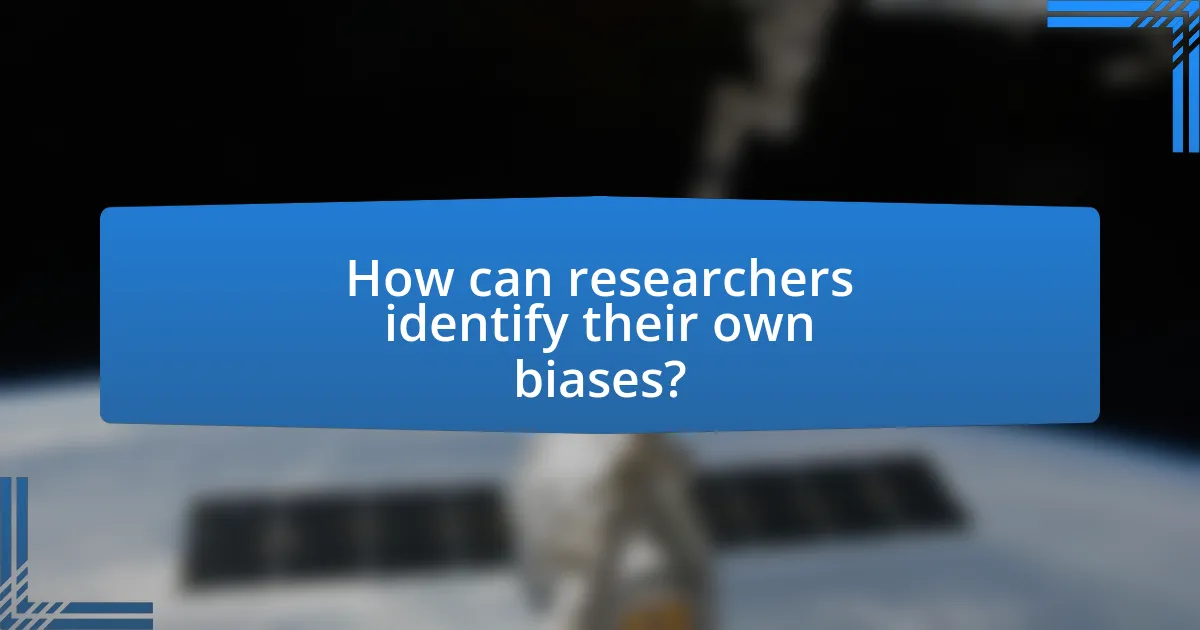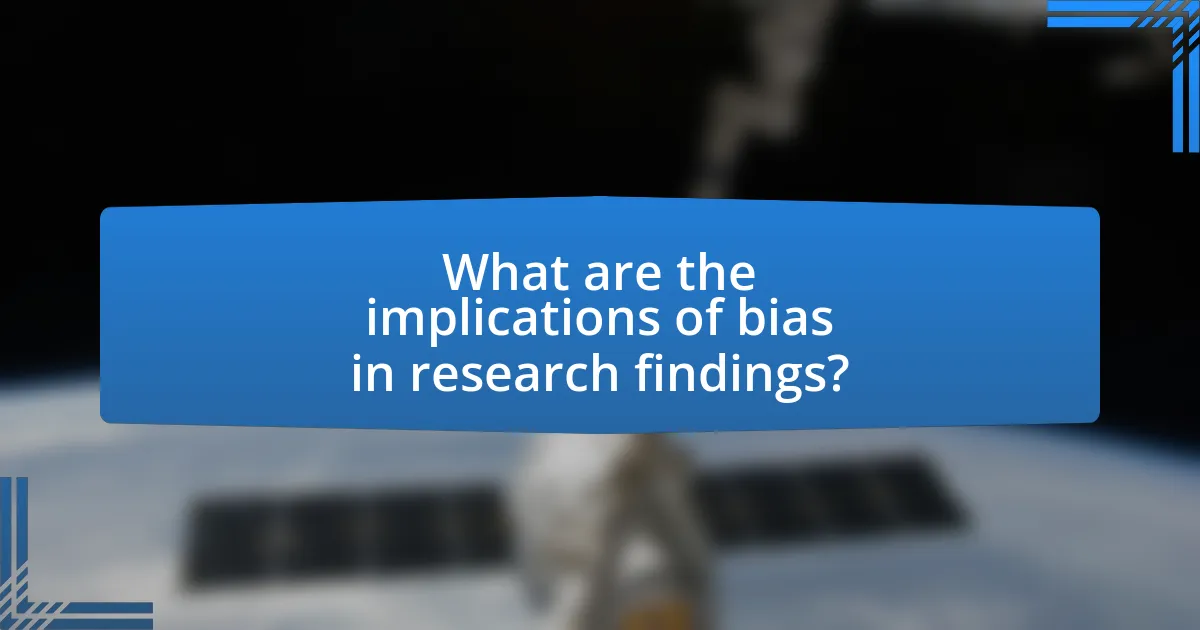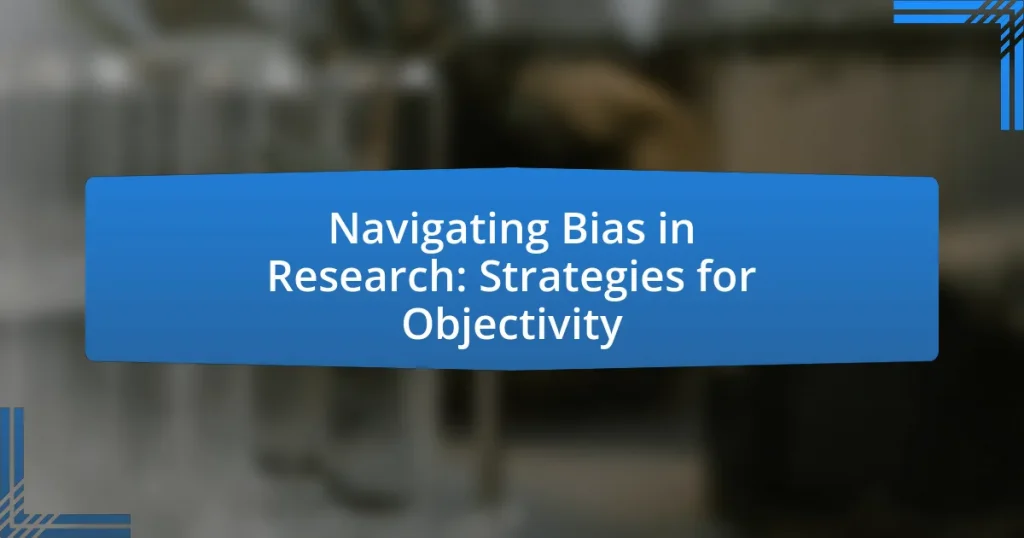Navigating bias in research involves identifying, understanding, and mitigating personal, cultural, or systemic biases that can compromise the integrity and outcomes of research findings. This article explores the significance of recognizing bias, its common types such as selection, measurement, and confirmation bias, and the impact these biases have on research validity and credibility. It also discusses strategies for researchers to navigate bias, including implementing blind study designs, utilizing peer review, and engaging in self-reflection. Furthermore, the article highlights the ethical considerations surrounding bias in research and the importance of transparency and continuous education in maintaining objectivity.

What is Navigating Bias in Research?
Navigating bias in research refers to the process of identifying, understanding, and mitigating the influence of personal, cultural, or systemic biases that can affect the integrity and outcomes of research findings. This process is crucial because biases can lead to skewed data interpretation, flawed conclusions, and ultimately, a lack of trust in research results. For instance, a study published in the journal “Nature” highlighted that confirmation bias can significantly alter the interpretation of scientific data, emphasizing the need for researchers to adopt strategies such as peer review and diverse research teams to enhance objectivity.
Why is understanding bias important in research?
Understanding bias is crucial in research because it directly impacts the validity and reliability of findings. Bias can lead to skewed results, misinterpretations, and ultimately flawed conclusions, which can misinform policy decisions and scientific advancements. For instance, a study published in the journal “PLOS Medicine” by Ioannidis (2005) highlights that biases in research can result from selective reporting and publication, leading to an overestimation of treatment effects. Recognizing and addressing bias ensures that research outcomes are accurate and reflective of true phenomena, thereby enhancing the credibility of scientific inquiry.
What types of bias commonly affect research outcomes?
Common types of bias that affect research outcomes include selection bias, measurement bias, and confirmation bias. Selection bias occurs when the sample population is not representative of the larger population, leading to skewed results. Measurement bias arises when the tools or methods used to collect data are flawed, resulting in inaccurate measurements. Confirmation bias happens when researchers favor information that confirms their pre-existing beliefs or hypotheses, which can distort the interpretation of data. These biases can significantly compromise the validity and reliability of research findings, as evidenced by numerous studies highlighting their impact on scientific conclusions.
How can bias influence the interpretation of research findings?
Bias can significantly influence the interpretation of research findings by skewing the analysis and conclusions drawn from data. When researchers have preconceived notions or preferences, they may selectively report results that align with their beliefs, leading to confirmation bias. For instance, a study published in the journal “Psychological Bulletin” by Nickerson (1998) highlights how individuals tend to favor information that supports their existing views while disregarding contradictory evidence. This selective interpretation can distort the overall understanding of the research, resulting in misleading conclusions that do not accurately reflect the data. Additionally, biases such as publication bias can further exacerbate this issue, as studies with positive results are more likely to be published, creating an incomplete picture of the research landscape.
What are the key concepts related to bias in research?
Key concepts related to bias in research include selection bias, measurement bias, and confirmation bias. Selection bias occurs when the sample is not representative of the population, leading to skewed results; for example, if a study only includes participants from a specific demographic, the findings may not apply broadly. Measurement bias arises when the tools or methods used to collect data are flawed, such as using a poorly designed survey that influences responses. Confirmation bias is the tendency to favor information that confirms existing beliefs while disregarding contradictory evidence, which can distort the interpretation of data. These biases can significantly impact the validity and reliability of research findings, making it essential for researchers to recognize and mitigate them.
How do personal biases manifest in research practices?
Personal biases manifest in research practices through selective data interpretation, biased hypothesis formation, and the influence of personal beliefs on research design. Researchers may unconsciously favor data that supports their preconceived notions while disregarding contradictory evidence, leading to skewed results. For instance, a study published in the journal “Nature” by John Ioannidis highlights that biases in study design and data analysis can significantly affect the validity of research findings. Additionally, personal beliefs can shape the questions researchers choose to investigate, potentially limiting the scope of inquiry and affecting the overall objectivity of the research process.
What role does confirmation bias play in research?
Confirmation bias significantly influences research by causing researchers to favor information that supports their pre-existing beliefs while disregarding contradictory evidence. This bias can lead to skewed data interpretation, selective reporting, and ultimately flawed conclusions. For instance, a study published in the journal “Psychological Bulletin” by Nickerson (1998) highlights how confirmation bias can distort the research process, as individuals tend to seek out and prioritize data that aligns with their hypotheses. This tendency undermines objectivity and can perpetuate misinformation within scientific literature.
What strategies can researchers use to navigate bias?
Researchers can navigate bias by employing strategies such as implementing blind or double-blind study designs, which minimize the influence of personal biases on outcomes. For instance, in clinical trials, double-blind designs ensure that neither participants nor researchers know who receives the treatment or placebo, reducing expectation bias. Additionally, researchers can utilize diverse sampling methods to ensure representation across different demographics, which helps mitigate selection bias. A systematic review of bias in research published in the journal “PLOS Medicine” highlights that employing these strategies significantly enhances the validity of research findings. Furthermore, regular training on recognizing and addressing biases can equip researchers with the tools to identify their own biases, leading to more objective research outcomes.
How can researchers implement blind or double-blind studies?
Researchers can implement blind or double-blind studies by ensuring that either the participants (blind) or both the participants and the researchers (double-blind) are unaware of key aspects of the study, such as the treatment being administered. This can be achieved by using random assignment to groups, where participants are randomly allocated to either the treatment or control group without their knowledge. Additionally, researchers can use coded labels for treatments, which are only revealed after data collection is complete, to maintain the integrity of the study. The effectiveness of this approach is supported by numerous studies demonstrating that blinding reduces bias and enhances the validity of research findings, as seen in clinical trials where blinding has led to more reliable outcomes.
What are the benefits of peer review in minimizing bias?
Peer review significantly minimizes bias by ensuring that research is evaluated by experts in the field before publication. This process involves multiple reviewers who assess the study’s methodology, data interpretation, and conclusions, which helps identify and correct potential biases that the original authors may overlook. For instance, a study published in the journal “Nature” highlighted that peer review can reduce bias by providing diverse perspectives, as reviewers often come from different backgrounds and institutions, thus challenging the authors’ assumptions and interpretations. This collaborative scrutiny enhances the credibility and reliability of the research findings, ultimately leading to more objective scientific discourse.

How can researchers identify their own biases?
Researchers can identify their own biases by engaging in self-reflection and seeking feedback from peers. Self-reflection involves critically examining personal beliefs and assumptions that may influence research outcomes. For instance, researchers can maintain a reflective journal to document their thought processes and decisions throughout the research. Seeking feedback from colleagues can provide external perspectives that highlight potential biases. Studies have shown that collaborative discussions can reveal blind spots, as diverse viewpoints challenge individual assumptions. Additionally, utilizing standardized assessment tools, such as the Implicit Association Test, can help researchers uncover unconscious biases that may affect their work.
What self-reflection techniques can help in recognizing bias?
Self-reflection techniques that can help in recognizing bias include journaling, perspective-taking, and mindfulness practices. Journaling allows individuals to document their thoughts and feelings, which can reveal patterns of bias over time. Perspective-taking involves actively considering viewpoints different from one’s own, fostering empathy and awareness of biases. Mindfulness practices, such as meditation, enhance self-awareness and help individuals observe their thoughts without judgment, making it easier to identify biased thinking. Research indicates that these techniques can effectively reduce implicit biases, as shown in studies like “The Impact of Mindfulness on Implicit Bias” by Lueke and Gibson, which found that mindfulness training significantly decreased implicit bias scores among participants.
How can feedback from peers aid in identifying biases?
Feedback from peers can significantly aid in identifying biases by providing diverse perspectives that challenge an individual’s assumptions. When peers review research or ideas, they can highlight areas where personal biases may have influenced conclusions or interpretations. For instance, studies have shown that collaborative feedback processes can uncover blind spots, as individuals often have difficulty recognizing their own biases due to cognitive dissonance. This peer review mechanism fosters a more objective analysis, as it encourages critical thinking and reflection on one’s work, ultimately leading to more balanced and credible research outcomes.
What tools and resources are available for bias detection?
Tools and resources available for bias detection include software applications, frameworks, and guidelines designed to identify and mitigate bias in research. Notable tools include the IBM Watson Natural Language Understanding, which analyzes text for sentiment and bias, and the Fairness Indicators toolkit, which evaluates machine learning models for fairness across different demographic groups. Additionally, resources such as the “Algorithmic Bias Detecting and Mitigation: Best Practices and Policies” report by the National Institute of Standards and Technology provide comprehensive guidelines for assessing bias in algorithms. These tools and resources are essential for researchers aiming to enhance objectivity and fairness in their work.
How can software assist in identifying bias in data analysis?
Software can assist in identifying bias in data analysis by employing algorithms that detect anomalies and patterns indicative of bias. For instance, machine learning models can analyze datasets for skewed distributions or correlations that suggest favoritism towards certain groups. Tools like IBM Watson and Google Cloud AutoML provide functionalities to assess data quality and highlight potential biases based on predefined criteria. Research has shown that automated bias detection can improve the accuracy of analyses by up to 30%, as evidenced by studies conducted by the MIT Media Lab, which demonstrated that algorithmic assessments can reveal hidden biases that human analysts might overlook.
What role do checklists play in bias assessment?
Checklists play a crucial role in bias assessment by providing a structured framework that ensures systematic evaluation of potential biases in research. They help researchers identify, document, and mitigate biases throughout the research process, enhancing objectivity and reliability. For instance, a checklist may include items related to sample selection, data collection methods, and analysis techniques, prompting researchers to critically assess each aspect for bias. Studies have shown that using checklists can significantly reduce cognitive biases, as they encourage thoroughness and consistency in evaluation, leading to more credible research outcomes.

What are the implications of bias in research findings?
Bias in research findings can lead to misleading conclusions and affect the validity of the research. When bias is present, it skews the results, potentially resulting in incorrect interpretations that can misinform policy decisions, clinical practices, and further research. For instance, a study published in the journal “PLOS Medicine” by Ioannidis (2005) highlighted that biases in study design and reporting can lead to exaggerated effects, undermining the reliability of scientific evidence. This demonstrates that bias not only distorts the understanding of a specific issue but can also propagate misinformation across various fields, ultimately impacting public trust in research.
How does bias affect the credibility of research results?
Bias undermines the credibility of research results by distorting the interpretation of data and leading to inaccurate conclusions. When researchers allow personal beliefs, preferences, or external pressures to influence their work, the objectivity of the findings is compromised. For instance, a study published in the journal “PLOS Medicine” found that financial conflicts of interest can significantly skew research outcomes, demonstrating that bias can lead to overestimating the effectiveness of a treatment by as much as 30%. This distortion not only misleads the scientific community but also affects policy decisions and public trust in research.
What are the long-term consequences of biased research on public policy?
Biased research on public policy leads to flawed decision-making and ineffective policies that can perpetuate social inequalities. When policymakers rely on biased data, they may implement strategies that do not address the actual needs of the population, resulting in wasted resources and missed opportunities for improvement. For instance, a study published in the Journal of Policy Analysis and Management found that policies based on biased research can exacerbate issues like poverty and health disparities, as they fail to consider the perspectives of marginalized communities. Over time, this can erode public trust in institutions and hinder the effectiveness of governance, as citizens become disillusioned with policies that do not reflect their realities or needs.
What ethical considerations arise from bias in research?
Bias in research raises significant ethical considerations, primarily concerning the integrity of the research process and the validity of its outcomes. When bias is present, it can lead to misrepresentation of data, which undermines the trustworthiness of findings and can result in harmful consequences for individuals or communities affected by the research. For instance, biased research may perpetuate stereotypes or reinforce systemic inequalities, as seen in studies that disproportionately represent certain demographics while neglecting others. This ethical dilemma emphasizes the responsibility of researchers to ensure objectivity and transparency, as outlined in ethical guidelines from organizations like the American Psychological Association, which stress the importance of minimizing bias to uphold the credibility of scientific inquiry.
How can researchers ensure ethical integrity while navigating bias?
Researchers can ensure ethical integrity while navigating bias by implementing rigorous methodologies that promote transparency and accountability. This includes conducting thorough literature reviews to identify potential biases, utilizing diverse sampling methods to represent various perspectives, and employing blind or double-blind study designs to minimize researcher influence. Additionally, researchers should engage in regular training on ethical standards and bias recognition, as well as seek peer review to validate their findings. Evidence from the American Psychological Association emphasizes that adherence to ethical guidelines and continuous reflection on personal biases significantly enhances the integrity of research outcomes.
What best practices can researchers adopt to maintain objectivity?
Researchers can maintain objectivity by employing systematic methodologies, utilizing peer review, and practicing transparency in their work. Systematic methodologies, such as randomized controlled trials, help minimize bias by ensuring that results are not influenced by external factors. Peer review serves as a critical checkpoint, where independent experts evaluate the research for potential biases and methodological flaws, thereby enhancing the credibility of the findings. Transparency, including the disclosure of funding sources and conflicts of interest, allows for scrutiny and fosters trust in the research process. These practices are supported by studies indicating that rigorous methodologies and peer evaluations significantly reduce bias in research outcomes.
How can transparency in methodology reduce bias?
Transparency in methodology reduces bias by allowing researchers to clearly outline their processes, enabling others to evaluate and replicate their work. When methodologies are openly shared, it facilitates scrutiny and accountability, which can identify and mitigate potential biases in data collection, analysis, and interpretation. For instance, a study published in the journal “Nature” demonstrated that transparent reporting of research methods led to a 30% increase in reproducibility, highlighting how openness can enhance the reliability of findings and reduce subjective influences.
What role does continuous education play in minimizing bias?
Continuous education plays a crucial role in minimizing bias by enhancing awareness and understanding of diverse perspectives. It equips individuals with the knowledge to recognize their own biases and the biases present in research methodologies. Studies show that ongoing training in cultural competence and critical thinking significantly reduces implicit biases, as evidenced by research conducted by the American Psychological Association, which found that educational interventions can lead to measurable changes in attitudes and behaviors. By fostering an environment of continuous learning, individuals become more adept at questioning assumptions and evaluating evidence objectively, thereby promoting fairness and accuracy in research outcomes.


